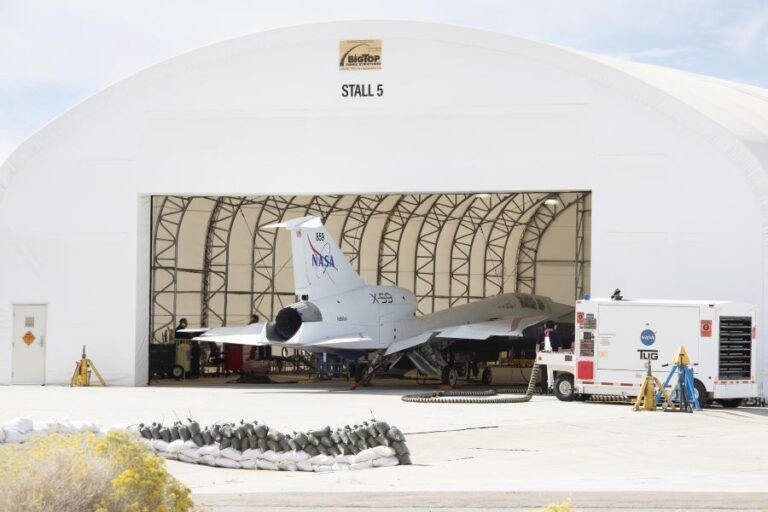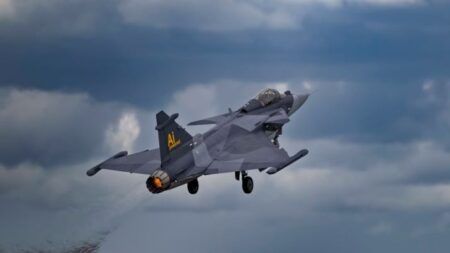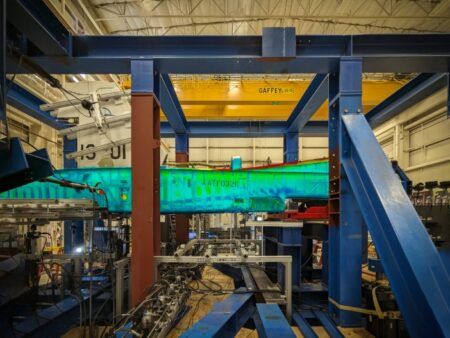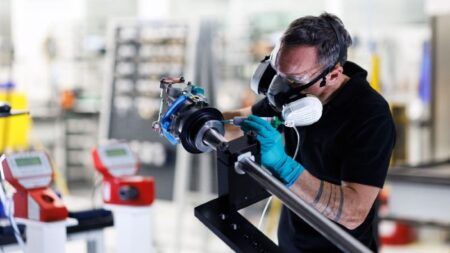NASA has started testing the X-59 Quiet SuperSonic Technology demonstrator aircraft’s engine, firing it up for the first time at the end of last month.
The Quiet SuperSonic Technology (Quesst) program started in 2016 to develop and validate new ways to minimize the noise made by aircraft when breaking the sound barrier. Engineers believe that a combination of aerodynamic features in its design will turn the characteristic supersonic boom into a thud that is more acceptable to people on the ground.
Data gathered from Quesst about how people perceive the supersonic thumps will be used by regulators to devise new rules for commercial supersonic flight over land. This will enable supersonic aircraft, such as the one that is being developed by Boom to operate at speeds faster than sound overland instead of just over seas.
The integrated engine-run tests at Lockheed Martin’s Skunk Works facility in Palmdale, California are verifying that the aircraft’s systems can work correctly using power from its own engine. Previous testing has used external power sources.
This first testing phase saw the engine rotated at a relatively low speed without ignition to check for leaks and ensure all systems are communicating properly. The team then fueled the aircraft and began testing the engine at low power to verify that it and other aircraft systems operate without anomalies or leaks while on engine power.
During later phases of engine testing, the aircraft will be tested at high power with rapid throttle changes, followed by simulating the conditions of an actual flight.
Jay Brandon, NASA’s X-59 chief engineer said, “The first phase of the engine tests was a warmup to make sure that everything looked good before running the engine,”
“Then we moved to the actual first engine start. That took the engine out of the preservation mode that it had been in since installation on the aircraft. It was the first check to see that it was operating properly and that all the systems it impacted – hydraulics, electrical system, environmental control systems, etc. – seemed to be working.”
X-59’s engine is a modified F414-GE-100, which can provide up to 22,000 lbs of thrust, propeling the aircraft to a cruise speed of Mach 1.4 (925mph) at an altitude of 55,000ft. The engine is located on top of the aircraft to help make the X-59 quieter.

“The success of these runs will be the start of the culmination of the last eight years of my career,” said Paul Dees, NASA’s deputy propulsion lead for the X-59. “This isn’t the end of the excitement but a small steppin gstone to the beginning. It’s like the first note of a symphony, where years of teamwork behind the scenes are now being put to the test to prove our efforts have been effective, and the notes will continue to play a harmonious song to flight.”
After the engine runs, the X-59 team will move to aluminum bird testing, where data will be fed to the aircraft under both normal and failure conditions. The team will then proceed with a series of taxi tests, where the aircraft will be put in motion on the ground. These tests will be followed by final preparations for first flight.
Challenges associated with the engine runs meant the X-59’s first flight is delayed from this year to early 2025. “The team will continue progressing through critical ground tests and address any technical issues discovered with this experimental aircraft. The X-59 team will have a more specific first flight date as these tests are successfully completed,” NASA said in a statement.





